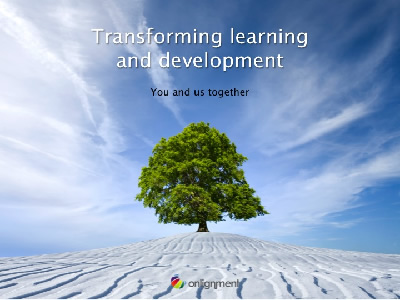![]()

In the first post in this series, we expressed a vision for learning and development that is aligned, economical, scalable, flexible, engaging and, above all, powerful in terms of the results it achieves. In this post, we look at the argument for l&d to be powerful.
Clearly, learning interventions are of little or no value to an organisation if they don’t have a positive impact on key performance indicators. There is a clear link here with alignment. For learning interventions to be powerful, they have first to be aligned to the organisation’s current and future needs.
Organisations are not, of course, the only stakeholders in workplace learning, even if they pay the bill. Learning is first and foremost an investment in the learner, the employee. It can also be regarded as an investment by the learner, who must be engaged if learning is to take place at all. A learning activity is powerful for a learner if it helps them to achieve mastery in their particular area of work and to build their confidence so that they find work more fulfilling and enjoyable.
So, what causes one learning intervention to be more powerful than another? Well, we have already established that the process has to start with alignment to the organisation’s and the learners’ requirements, something that will not happen by magic or guesswork. The only way to assess requirements is to consult with all the relevant stakeholders and that’s a time-consuming process.
An intervention also needs to teach the right things. This might seem obvious, but it is perfectly possible for an intervention to do a very effective job of developing the wrong knowledge and skills. For example, let’s say an organisation wants to increase turnover by adopting a new sales process. They could run a wonderful course which transfers efficiently back to the job. But if the process itself is flawed, then the net result may be lower sales not higher.
Thirdly, the intervention needs to be designed and delivered effectively. The research tells us that effective learning is largely down to choosing the right strategies and methods, and then implementing them well. Media choices, such as whether a particular activity or resource is delivered face-to-face or online, are certainly going to have an impact on flexibility, cost and time-efficiency, but will not usually determine whether or not the learning outcomes are achieved (see The No Significant Difference Phenomenon).
Lastly, the power of an intervention will very often depend on the commitment of learners’ managers. Newstrom and Broad found that the positive involvement of managers before and after an intervention was more likely to influence the end result than any actions by trainers and by learners themselves.
Coming next: What we can do to make this vision a reality
Tag: transformation
The vision: 5. Learning and development that is engaging
![]()

In the first post in this series, we expressed a vision for learning and development that is aligned, economical, scalable, flexible, engaging and, above all, powerful in terms of the results it achieves. In this post, we look at the argument for l&d to be engaging.
Learning interventions need to be engaging, because without learner engagement there’s very little chance that any meaningful learning will take place. Engaging interventions attract and maintain interest, they arouse the emotions, they are full of energy. Just like learning should be.
In Switch – How to Change Things When Change is Hard, by Chip and Dan Heath, the authors make a key distinction between what we think consciously and what our more primitive, emotional system will have us do. They liken the emotional system to an elephant and the intellect to the rider of the elephant. As you can imagine, when you’re trying hard to resist that bar of chocolate or force yourself up out of bed on a cold morning, the rider has a heck of a job keeping the elephant under control and can easily become exhausted in the process.
Engaging the learner is about getting the elephant on board. While the rider may be engaged by the long-term benefits of a learning activity or an intellectual curiosity, the elephant is much more interested in what’s in it for him right now. The prospect of a solution to a real, current problem will definitely do the job, because relevance will always drive out resistance. The elephant may also be motivated by a challenge – perhaps a game which involves some form of competition. Humour may also do the trick, or just plain novelty.
Being engaged can be likened to a state of flow, as described by the psychologist Mihaly Csiksczentmihalyi. He describes this state as follows:
Confronting tasks that we have a chance of completing
Concentration
Clear goals
Immediate feedback
A deep, effortless involvement
A sense of control over one’s actions
A reduced concern for self
Hours pass by in minutes
You may find it a daunting challenge to design and deliver learning interventions that are capable of inducing such a state of mind, but in the right circumstances the motivation to learn can be very strong. As Daniel Pink describes in Drive: The Surprising Truth About What Motivates Us, three factors stand out: the desire to direct our own lives; the urge to get better and better at something that matters; and the yearning to do what we do in the service of something larger than ourselves. Provide learning opportunities with a clear purpose, a direct relevance to real-world issues and a highly-flexible and learner-centred methodology and you’ll be more than half the way there.
Coming next: The vision: 6. Learning and development that is powerful
The vision: 4. Learning and development that is flexible
![]()

In the first post in this series, we expressed a vision for learning and development that is aligned, economical, scalable, flexible, engaging and, above all, powerful in terms of the results it achieves. In this post, we look at the argument for l&d to be flexible.
Flexibility is an important element in the vision for a transformed l&d. What it implies is more control for l&d’s customers – the employees of an organisation. Adults expect to have control over what they learn, when and where and will increasingly demand it. They expect it because they have grown accustomed to finding whatever information they need at the click of a mouse from Google, YouTube and Wikipedia. Synchronous learning (that takes place with others, at a specific time, perhaps in a virtual classroom) can be powerful, but it is certainly not flexible. It means you have have to compromise on when you learn in order to suit others. Similarly, face-to-face learning can add a great deal of value when used for the right purposes, but is highly inflexible. Being face-to-face means you have to compromise on where you learn in order to suit others.
Flexibility can take many forms. For the learner it can mean:
- Controlling what you learn and to what level: So much traditional training is one-size fits all. Everybody starts and ends at the same place, regardless of need. But every learner is different in terms of their prior knowledge and goals, and it is not rocket science to organise training in a modular fashion. Providing this sort of flexibility is not always practical, but it should at least be an aim.
- Controlling how you learn: This is a tricky one, because there has been a lot of nonsense talked about learning styles and how different we are in how we like to learn, yet we are actually much more alike than we are different and it is usually uneconomical to offer training in alternative forms. However, there are sometimes obstacles that get in the way of learners taking advantage of a particular form of learning (disabilities, access to technology, inability to travel, etc.) and providing alternatives can be beneficial, if not compulsory.
- Controlling when you learn and at what pace: By and large, learners would prefer not to have to wait to learn something which is important to their work. They’d also like to control when they learn, for how long, how fast and how slow. Having to conform to someone else’s timetable is always going to be a compromise solution.
- Controlling where you learn: Having to travel to a central location for training is sometimes necessary, but is typically an expensive and time-consuming activity. If you can avoid it you should. It also makes sense to provide learners with the opportunity to continue their learning when they are on the move, so they can take advantage of the inevitable dead times on trains, in airports and hotel rooms.
Of course it can be extremely difficult to provide all this flexibility without impacting heavily on our other objectives of scalability and economy – we have to strike the right balance. But flexibility is a worthwhile target to have in mind and you can make big strides in this direction by creating more modular interventions, with a greater use of self-paced components, and by delivering online when possible.
Coming next: The vision: 5. Learning and development that is engaging
The vision: 3. Learning and development that is scalable
![]()

In the first post in this series, we expressed a vision for learning and development that is aligned, economical, scalable, flexible, engaging and, above all, powerful in terms of the results it achieves. In this post, we look at the argument for l&d to be scalable.
Learning interventions are scalable when they are capable of delivering high quality results to ever larger audiences. There’s little doubt that, when used for the right purpose and well executed, one-to-one learning can be extremely effective but it is hardly scalable; after all, there are only so many hours in a day that any instructor, coach or mentor can dedicate to the task. While there is often a need to include an element of one-to-one or small group learning in a blend, because that’s the only way of making sure the job gets done right, there are many occasions on which far more scalable methods can be applied.
Some fantastic progress has been made recently in realising the concept of massively scalable education. Particularly exciting examples are the Khan Academy, which has contributed to the maths education of millions, and the free online courses being run by faculty at Stanford University. An Introduction to Artificial Intelligence, led by Peter Norvig and Sebastian Thrun, attracted some 160,000 enquiries, of which 25,000 or more have made it through to its conclusion. If you are not familiar with these projects, you can see Khan, Norvig and Thrun discussing the implications of their work in Reinventing Education – 45 minutes of very watchable YouTube video.
So, yes, you can teach maths and science to millions at practically no cost using videos and quizzes, and this is a fantastic step forward, but can we make similar gains in workplace learning? Currently, skills development is a labour-intensive and very costly business, typically involving a great deal of face-to-face contact with a trainer or coach. Some individuals, some organisations, some countries have been able to afford this and will be able to sustain this investment even in a harsh economic climate. That leaves an awful lot of skills gaps and unemployed people.
The pressure for more scalable learning and development at work is accentuated by the increased pace at which change takes place within organisations. More often than not there simply isn’t the time available to wait for ‘high-touch’ training. L&d needs a plan B; one that much better leverages limited subject expertise and teaching skills.
Coming next: The vision: 4. Learning and development that is flexible
The vision: 2. Learning and development that is economical
![]()

In the first post in this series, we expressed a vision for learning and development that is aligned, economical, scalable, flexible, engaging and, above all, powerful in terms of the results it achieves. In this post, we look at the argument for l&d to be economical.
It almost goes without saying in today’s testing times that learning and development needs to be economical. In fact, there has always been this need. It is incumbent on any manager, regardless of function, to utilise as few of the organisation’s resources as possible in fulfilling their responsibilities. L&D is no different. It makes no difference whether you regard training as a cost or an investment. If a cost, then the organisation’s profits will be maximised by keeping this to a minimum. If an investment, then you are obligated to keep this as small as it can be without unduly threatening the returns.
Although it is dangerous to generalise, it is probably fair to say that, until 2008 and the credit crunch, l&d budgets had not been the subject of much critical examination as long as they were in line with historical levels and comparable to those of other, similar organisations. This situation has changed and how. Budgets in the USA took a hit of 20% or more and the story in the Europe is not so different. Even richer organisations, not seemingly under pressure, have become defensive about expenditure. Conserving cash is the name of the game. Senior managers no longer take the l&d budget as a given; it has to be justified from the bottom-up as just one of a number of means for influencing performance and competitiveness. This should alway have been the case. It is best to assume that, from now on, it always will be.
One way that l&d can have a much greater influence on organisational expenditure is by making sure that it considers the full cost of any intervention, not just the obvious ones which require a cheque to be written. By far the greatest cost in any intervention is learner time. Every hour spent away from productive work is a cost to the organisation and one that should be minimised. Sometimes this cost is directly visible because overtime has to be paid or contractors brought in to cover the lost time. But even if this is not the case, the cost is still real; time spent learning could have been used productively elsewhere – in other words, there is an opportunity cost. Indirect costs occur within the l&d department as well. Time spent by salaried staff on design, development and delivery of any intervention should be costed against that intervention. And yes, we are proposing that time sheets are maintained, so the cost can be accurately monitored.
It is hard to argue against accurate budgeting and cost monitoring of l&d interventions, yet this is very rarely carried out in practice. Yes, the obvious, direct, external costs – like the use of external trainers and e-learning developers – are closely watched, but these are only a small proportion of the true cost. It’s time l&d took responsibility for its true effect on the finances of the organisations that it serves.
Coming next: The vision: 3. Learning and development that is scalable
The vision: 1. Learning and development that is aligned
![]()

In the first post in this series, we expressed a vision for learning and development that is aligned, economical, scalable, flexible, engaging and, above all, powerful in terms of the results it achieves. In this and the five posts that follow, we’ll take each of these in turn, starting with the need for learning and development that is aligned. In this case, we’ll use an extract from The New Learning Architect:
It is nothing new to be told that training should be aligned to the needs of the business, but that doesn’t mean that it ‘goes without saying’ or is ‘common sense’. All too often, common sense is anything but common. Ask yourself how many of the training interventions in your organisation are clearly aligned to current business needs, rather than fulfilling requirements articulated sometime in the distant past, but which have no current relevance. And how many interventions have originated from the l&d department on the basis of where they believe the organisation should be heading, regardless of the views of senior management? No organisation ever set up an l&d department so this department could then determine the direction for the organisation. It is not up to l&d professionals to decide what is good leadership, what is good customer service or what are appropriate values for the organisation. Their job is to help senior management make their vision a reality, regardless of whether that vision is shared by the professionals that staff the l&d department.
A good question to ask is this:
What behaviours are critical to the future success of this organisation?
Let’s unpick this a little. You need to know about ‘behaviours’ because, of all the various factors which influence the success of an organisation, only these can be influenced by learning and development. You need to find out which are the ‘critical’ behaviours, because you don’t have the resources to devote to the non-critical. And you need to focus on ‘future success’, because learning and development is an investment in the future and can do little to influence what happens right now. The only people who can answer this question with any authority are senior management.
The question can and should also be addressed for each of the main functional and regional departments and divisions within the organisation, as well as at various levels. For example: “What behaviours are critical to the future success of the IT department or European region”; “What middle management behaviours are critical to the future success of the organisation?”
Once you know what behaviours are required if the organisation is to succeed in the future, you need to assess the extent of the task in front of you:
To what degree are employees already exhibiting the behaviours that are critical for success?
Answering this question is no small task. If you work for a larger organisation, then ideally you’ll have set up a performance management system which enables you to keep track of how individuals are performing. This will include a competency framework covering every job position; one that is up-to-date with the constant and inevitable changes in job responsibilities and which describes the behaviours that senior management are looking to encourage. In order for you to assess the extent to which these competences are evidenced in actual performance, all employees will have been regularly assessed against this framework or will have conducted some form of self-assessment. Smaller organisations may not have gone so far, but they should at very least be conducting regular performance appraisals.
If, having carried out your research, you find no gaps, then your only problem is ensuring the continued supply of employees who exhibit the desired behaviours. You should be so lucky! Chances are you’ll have to ask one more question:
What influence can learning and development have on these behaviours?
Performance is influenced by a lot more than skill and knowledge. Situational influences on the performer include the clarity of roles and objectives, the suitability of the working environment, and the tools and other resources at the performer’s disposal. The performer him or herself has aptitudes (indicating his or her potential to learn) and motivations, as well as their accumulated knowledge and skills. The performer’s responses are also influenced by outcomes (the incentives and disincentives that are likely to result from performing in a certain way) as well as the timely availability of relevant feedback. The whole performance system has to be functioning correctly if performers are to exhibit the desired behaviours. Learning and development is only going to work if (1) unsatisfactory performance can at least partly be attributed to a lack of knowledge or skills, and (2) the employees in question have the aptitude to acquire these.
L&d professionals may have to be assertive in conducting and communicating this sort of logical analysis. As Wick, Pollock, Jefferson and Flanagan remind us, “The problem typically begins when someone in upper management decrees that the company needs to have a programme on some particular topic. And when the goal of having a programme is defined as ‘having a programme’, the initiative is in trouble from the start.” Senior managers may be experts in determining the problems that are getting in the way of performance, but they are not experts in finding the solutions – that’s your job, and this is your time to speak up.
Coming next: The vision: 2: Learning and development that is economical
Transforming learning and development: the need
![]()

Do any of the following apply to you?
- Budgets for training are flat or reducing.
- Managers are finding it harder to release their staff for days at a time to attend training programmes.
- Travel budgets are under pressure making it harder for participants to travel to central training locations.
- Learning & development staff are apprehensive about the idea of using new learning technologies.
- You have had a poor experience in the past of using rather tedious self-study e-learning.
- You are reluctant to compromise on the quality of the solutions you offer.
- You know you really do have to make changes but you’re not sure where to start.
If your answer to any of the above is ‘yes’ then it will be small comfort to know that you are not alone. The fact is that changes are necessary and sooner rather than later.
Over the past three years, as we in the learning and development profession have battled with almost unparalleled levels of uncertainty and pressure on resources, my colleagues at Onlignment and I have found ourselves engaged more and more often in discussions with learning providers, both external and in-house, looking to reinvent their offerings for their particular markets.
Of course this is not the first time that learning providers have had to struggle with tight market conditions. But this may well be the first time that customers – internal and external – are beginning to question the basis of the service offering. So what’s changed?
First of all, customers cannot any longer afford for their employees to be off-job for protracted periods. That’s because they don’t have the spare capacity they once had to cover the time lost, and they need all hands on deck. They are also short on budget and, as we all know, training (particularly when external) is one of the easiest expenses to cut. However much we might complain about the importance of learning as an investment in the future, I doubt if any company ever went bust because they delayed formal training when times were tight. We have to accept that fact and realise that learning is typically a medium to long term investment, and some organisations have not been so sure they are going to have a medium to long term.
Customers are also more aware of the environmental impact of excessive employee travel. A good proportion of those cars on the motorway or planes in the air are carrying people to learning events, and not always in situations where face-to-face contact is essential to success. The environment may not be the biggest issue on anyone’s agenda right now, but it will return as economic conditions improve. By then, many organisations will have got used to the idea that many meetings and other events can be handled perfectly adequately using web conferencing.
Finally, there is an increasing awareness that stand-alone classroom interventions have a limited impact on job performance. However enjoyable they may be at the time, and however high the knowledge assessment scores might be at the end, these are no guarantee that what is learned will be retained, applied and then put to good use.
In this series of posts, we’ll start by developing a vision for a transformed learning and development function; one that is aligned, economical, scalable, flexible, engaging and, above all, powerful in terms of the results it achieves. We’ll move on to look at some of the changes that can be made to realise this vision, expressed as six shifts:
- from generic to tailored solutions
- from synchronous to asynchronous
- from compliance to competence
- from top-down to bottom-up
- from courses to resources
- from face-to-face to online
In each case we’ll be making clear that these are shifts along a continuum, not the abandonment of practices that clearly deliver results. We’ll also keep reminding you that every situation is different and that every organisation needs to strike its own balance
Lastly, we’ll spell out a process that will get you started on the journey to transformation, starting with a thorough analysis of your particular requirements, target populations and constraints. We’ll look at the implications these have in terms of your learning architecture and infrastructure, the way you analyse performance needs and design blended solutions, and the skills you’ll need to take advantage of new learning technologies.
Coming next: The vision: 1. Learning and development that is aligned
